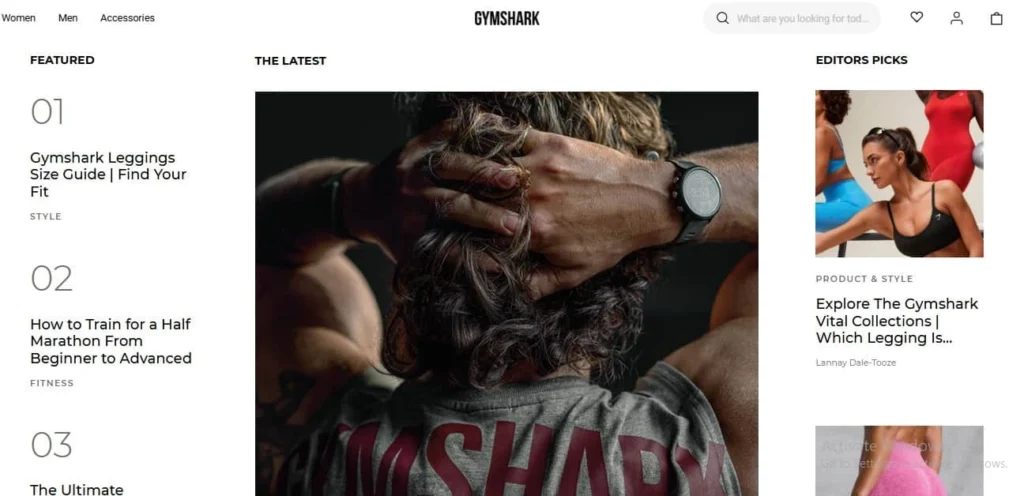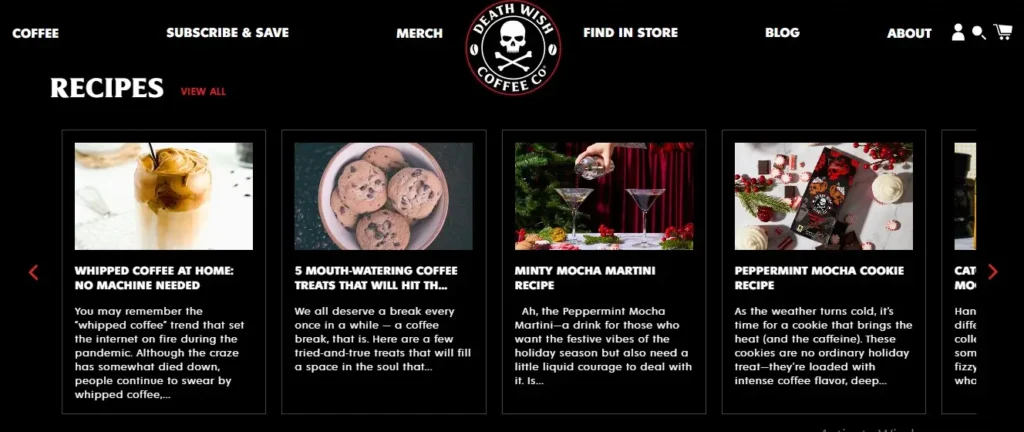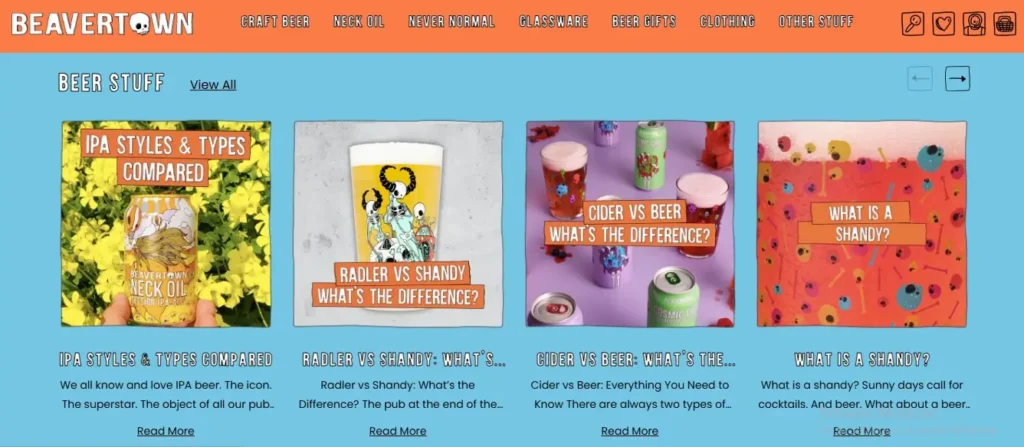Content marketing has become one of the most effective ways to grow an eCommerce brand, and Shopify blogs are at the heart of this strategy. A well-designed, regularly updated blog can drive qualified traffic, boost search engine rankings, and position your store as an authority in your niche — all without heavy ad spend.
Whether you sell handmade jewelry, fitness gear, or digital products, a blog gives your Shopify store a voice. It lets you educate potential customers, answer their questions, and showcase your products in a way that feels natural and trustworthy. In fact, many of the world’s most successful Shopify stores run thriving blogs that bring in organic visitors and convert them into loyal buyers.
In this guide, we’ll explore the best Shopify blog examples you’ll want to copy, explain what makes them successful, and share actionable tips you can use to build or improve your own. By the end, you’ll know exactly how to leverage Shopify’s built-in blogging features to attract more readers, rank higher on Google, and increase your sales.
Need help while customizing your theme? Here’s how to contact Shopify support in 2025 if you run into any issues.
Why Blogging Matters for Shopify Stores
While Shopify is widely known for its powerful eCommerce features, many store owners overlook the built-in blogging functionality. Yet a blog is one of the most effective tools you have for building trust and driving consistent, organic traffic to your store. Here’s why:
Boosts Organic Traffic and SEO
Every blog post you publish is a new page that can rank on Google. Targeting the right keywords lets you show up in search results when potential customers are actively looking for information or solutions related to your products. Over time, this compounds — more posts mean more opportunities to attract visitors without paying for ads.
Establishes Authority in Your Niche
Customers want to buy from experts, not just sellers. A Shopify blog allows you to demonstrate your expertise by answering questions, providing tips, and sharing insights. When readers find value in your content, they’re more likely to trust your brand and buy from you.
Supports the Buyer’s Journey
Not every visitor is ready to purchase immediately. Blogging helps nurture them through the decision-making process. By addressing pain points, showcasing product benefits, and offering educational content, you can gently move readers from awareness to purchase.
Creates Content for Social Media and Email
Every blog post you write can be repurposed into social media content, newsletters, or even lead magnets. This multiplies your marketing efforts without multiplying your workload.
Increases Customer Lifetime Value
Blogs are not just for attracting new visitors. They also help you engage with existing customers through tips, tutorials, and new product updates, increasing retention and repeat purchases.
Start a free trial and enjoy 3 months of Shopify for $1/month
🚀 Start Shopify TrialTrusted by over 2,000,000 businesses worldwide
What Makes a Great Shopify Blog?
Not all Shopify blogs are created equal. Some are just product announcements; others become go-to resources that attract thousands of readers and customers. A great Shopify blog blends strategy, design, and content to keep visitors engaged and drive conversions. Here’s what sets high-performing blogs apart:
Clear Purpose and Audience Focus
Every post should be written for a specific type of reader. The best Shopify blogs identify who they’re speaking to (new customers, loyal fans, or a niche community) and craft content that solves their problems. This clarity builds loyalty and keeps bounce rates low.
Consistent, High-Quality Content
Publishing once in a while isn’t enough. Great blogs maintain a consistent posting schedule and deliver well-researched, original articles. This tells search engines — and readers — that your store is active and trustworthy.
Strong SEO Foundation
Successful Shopify blogs are optimized for search from the ground up. They target strategic keywords, use descriptive headings (H2/H3), include meta descriptions, alt text for images, and internal links to related products or pages. This improves rankings and increases organic traffic.
Visual Appeal and Branding
Design matters as much as text. Great Shopify blogs feature clean layouts, branded colors, high-quality images, and scannable formats. This creates a professional look that builds trust and enhances your store’s identity.
Valuable, Actionable Content
Readers should walk away having learned something or feeling inspired to act. Tutorials, how-tos, case studies, and product tips are especially effective. The best blogs subtly connect these lessons back to products, encouraging natural conversions without feeling salesy.
Easy Navigation and User Experience
Categories, tags, and a clear structure help visitors find what they’re looking for. Excellent Shopify blogs also load fast, look great on mobile, and are accessible to all users.
Integration with Store and Marketing
Finally, high-impact blogs work seamlessly with the rest of the store. They include strategic calls-to-action, related product recommendations, email sign-up forms, and links to social channels — all without overwhelming the reader.
Learn how to effectively add customer reviews on your Shopify store to enhance trust, increase engagement, and boost overall sales conversions.
Best Shopify Blog Examples You’ll Want to Copy
Gymshark (Fitness Apparel)
About GymShark
- Average Monthly Organic Traffic: 2. 100,000
- Who they are: Gymshark is a UK-based fitness apparel brand founded in 2012. Known for sleek, performance-driven gear and a powerful social media presence, it’s built a global fitness community.
Why it stands out
Gymshark’s blog is a fitness powerhouse, regularly updated with workout guides, style tips, and brand stories. Its content is high-quality and relevant – mixing expert-backed fitness advice with on-brand storytelling. The design is clean and professional, with strong visuals and easy navigation that enhance readability. SEO-wise, Gymshark categorizes posts by topics (e.g. Fitness, Product & Style) and uses keywords like “training” and “fitness trends” in titles. The blog is updated very frequently (several times a week) – for example, new posts appear daily (see multiple Sept. 2025 entries) – ensuring consistency.
Products are Well-integrated: Blog posts often link to relevant gear (like running apparel or accessories), and CTAs (e.g. shop the look) are naturally embedded.
What readers can learn:
Mix education with brand storytelling to engage your audience, update posts frequently to keep readers returning, and maintain a clean layout with high-quality images to boost readability and trust.
Once your store is fully branded, the next step might be multi-channel selling—here’s how to connect Shopify to Amazon easily.
ThirdLove (Lingerie & Apparel)
About ThirdLove
- Average Monthly Organic Traffic: 270,000
- Who they are: ThirdLove is a women’s intimate apparel brand known for comfort, inclusive sizing, and fit-focused design. They offer bras, underwear, and loungewear tailored to real women’s bodies.
Why it stands out
ThirdLove’s blog effectively showcases its products through interactive and informative content. Visitors can find sizing tips, comfort advice, and engaging tools like quizzes and comparison tables that make the learning process enjoyable. The blog design is clean and modern, featuring “Find your fit” buttons and seamlessly integrated product links within articles, creating a user-friendly experience.
From an SEO perspective, the blog focuses on keyword-rich topics such as “bra sizing” and “lingerie trends,” helping to drive organic traffic. The content is structured with clear headings and organized sections, making it easy for readers to navigate and find what they’re looking for.
The blog also supports ThirdLove’s e-commerce strategy with subtle calls-to-action and links to relevant products, like featured bras and underwear. It’s updated regularly, especially during key shopping periods, ensuring fresh content that aligns with customer interest and seasonal demand.
What readers can learn:
Use interactive elements (quizzes, tables) to engage users and guide them toward products without being pushy. Embed product links smartly within content so readers can seamlessly shop while learning about your products.
Find the best third-party logistics providers to help scale your Shopify business through fast, reliable, and cost-effective order fulfillment.
Start a free trial and enjoy 3 months of Shopify for $1/month
🚀 Start Shopify TrialTrusted by over 2,000,000 businesses worldwide
Death Wish Coffee (Beverages & Coffee)
Image Source Death Wish Coffee
About Death Wish Coffee
- Average Monthly Organic Traffic: 65,000
- Who they are: Death Wish Coffee is known for producing the “world’s strongest coffee.” With bold flavor, high caffeine content, and an edgy brand identity, it caters to serious coffee lovers seeking a strong brew
Why it Stands Out
Death Wish Coffee’s blog stands out with its bold, irreverent tone that perfectly matches the brand’s identity as the maker of the “world’s strongest coffee.” The content is diverse and engaging, covering everything from coffee culture and brewing tips to humorous takes like “Psychopath” drinking. This edgy voice not only entertains but also creates a memorable brand experience that resonates with its target audience.
The blog is optimized for both readers and search engines, featuring keywords like “coffee treats” and “espresso guides” to attract coffee enthusiasts. Visually, the site uses high-quality images and a dark, moody aesthetic that aligns with the brand’s bold personality. The content is well-organized, with dedicated categories such as “Recipes” that feature easy navigation and visually appealing layouts.
Product integration is smooth and non-intrusive, with “Shop Coffee” banners and contextual product links within posts—especially in recipe articles that highlight specific coffee blends or seasonal flavors. Overall, Death Wish Coffee’s blog demonstrates how a strong, unique voice combined with valuable content and natural product placement can boost engagement and drive conversions.
What readers can learn:
Give your blog a unique voice to stand out for example (Death Wish’s irreverence is memorable). Provide expert tips or fun content (e.g. brewing guides, recipes) to establish authority. Integrate product CTAs naturally (e.g. link to beans in a recipe) rather than hard-selling.
Master proven tactics for driving high-quality traffic to your Shopify store using SEO, social media, paid ads, and influencer marketing.
Beavertown Brewery
Image Source Beavertown Brewery
About Beavertown Brewery
- Average Monthly Organic Traffic: 48,000
- Who they are: Beavertown Brewery is a London-based craft brewery known for bold, flavorful beers like Neck Oil and Gamma Ray, paired with distinctive, comic-style artwork and a rebellious, creative spirit.
Why it Stands Out
Beavertown’s Planet Blog greets visitors with its quirky, engaging tone: “you’ve crash landed on Planet Blog – where all the weird and wonderful Beavertown content is stored”—setting an immediate brand personality that’s playful and fun. It combines eclectic topics—from beer pairings and London pub guides to whimsical pieces like “cute dogs in pubs next to a refreshing pint”—keeping readers entertained and intrigued.
Structurally, the blog is well-organized by categories like Beer Stuff, About Us, Events, Competitions, and more. This clear navigation allows readers to quickly access content relevant to their interests, enhancing usability. Additionally, each post is visually appealing—with vibrant imagery that reflects Beavertown’s bold, comic-art aesthetic—strengthening brand identity and reader immersion.
Finally, the content offers real value; readers can learn practical tips (like what beer pairs well with Christmas dinner or how to find dog-friendly pubs in London) while also connecting with the brand’s story and culture. This balance of useful information and brand storytelling keeps the blog both valuable and distinctive
What readers can learn:
Infuse Your Brand Personality
Don’t just inform—invite readers into your world. Let your unique voice shine through in blog intros and content tone, helping build emotional connection and memorability.Organize Thoughtfully
Use clear, intuitive category navigation so readers can easily find what interests them—whether it’s tutorials, behind‑the‑scenes stories, how‑tos, or product launches.Blend Utility with Storytelling
Offer content that’s both helpful (e.g., “How to care for your product,” “Best usage tips”) and brand-defining. Mix practical advice with stories of your brand, team, or community to engage and build trust.
Stay ahead of the curve with trending, high-demand products to sell on your Shopify store in 2025.
Huel
About Huel
- Average Monthly Organic Traffic: 405,000
- Who they are: Huel (from “Human + Fuel”) is a British-based food brand founded in 2015 by Julian Hearn and nutritionist James Collier. Their mission: to deliver nutritionally complete, affordable, plant‑based meals and support a more sustainable food system.
Why The Huel Digest Stands Out
Huel’s blog, The Huel Digest, delivers expert-led, in-depth content ranging from nutrition breakdowns and ingredient reviews by their in-house team to fitness insights from professionals, and long-form explorations of self-development, sustainability, and mental health. This breadth signals credibility and positions the brand as more than just a product—it’s a source of education and lifestyle guidance.
The blog is structured to be highly user-friendly and inclusive. It offers specially tailored content for healthcare professionals, ensuring diverse audience engagement. Categories seem to be thoughtfully organized (as observed in Huel’s multilingual regional sites), helping readers easily explore topics by interest or need.
Visually, The Huel Digest maintains clarity and focus. The design features centered, minimalist layouts that eliminate distractions and emphasize the written content—especially important for long-form, informative articles. This simplicity keeps readers immersed in the material and supports the authoritative tone of the brand.
What Shopify Merchants Can Learn
Position Your Blog as Expertise, Not Just Marketing
Create content that educates—like ingredient deep-dives, expert tips, or lifestyle pieces—so your brand becomes a trusted source, not just a seller.Organize for Clarity and Inclusivity
Use intuitive categorization (e.g., nutrition, sustainability, wellness) to guide readers smoothly through your blog offerings. If applicable, consider professional or niche audience segments too.Simplify Design to Showcase Content
Adopt clean, centered layouts with minimal distractions. Let your words take center stage, especially for long-form content where depth and readability matter most.
Want to customize your store’s branding? Learn how to easily remove the “Powered by Shopify” message from your footer.
Actionable Tips to Build a Successful Shopify Blog
Creating a Shopify blog that actually drives traffic and sales takes more than posting random updates. It requires a strategy, clear branding, and consistent execution. Below are actionable tips to help you build a blog that stands out, ranks well, and converts readers into customers.
Define Your Blog’s Purpose and Audience
Before you write your first post, identify exactly who you’re writing for and why. Are you trying to educate customers, attract organic traffic, showcase brand expertise, or build community? A clear goal will guide your tone, topics, and calls-to-action. For example, a skincare Shopify store might focus on how-to guides, ingredient spotlights, and lifestyle posts for eco-conscious beauty shoppers.
Create a Content Strategy and Editorial Calendar
Random posting leads to inconsistent results. Instead, build an editorial calendar that outlines blog topics, keywords, and publishing dates. Map your posts to the buyer journey – awareness (educational content), consideration (comparisons, tutorials), and decision (case studies, reviews). This ensures a steady flow of content that moves readers toward purchase.
Focus on High-Quality, SEO-Optimized Content
SEO is the backbone of any successful Shopify blog. Research long-tail keywords using tools like Ahrefs, Semrush, or Ubersuggest, and integrate them naturally into your titles, headings, and meta descriptions. Make sure each post is at least 1,000 words with clear formatting, bullet points, and internal links. Shopify’s built-in blogging platform makes it easy to edit meta fields and alt text for images—use this to your advantage.
Use Compelling Visuals and Branding
Your blog should look and feel like your store. Use high-quality photos, infographics, and videos that align with your brand identity. Incorporate your logo, colour palette, and typography so that your blog becomes a seamless part of your Shopify storefront. Visual storytelling keeps readers engaged longer, which also benefits your SEO.
Write Engaging, Click-Worthy Headlines
Headlines determine whether people click or scroll past. Use clear, benefit-driven titles like “How to Choose the Right Eco-Friendly Yoga Mat” or “5 Skincare Ingredients You’re Using Wrong.” Add numbers, power words, or questions to make them irresistible while still including your primary keyword.
Make Every Post Action-Oriented
Each post should guide readers to take the next step—whether that’s subscribing to your email list, reading another post, or checking out a product. Use CTAs (calls-to-action) throughout your content, ideally with buttons or banners that stand out. The goal isn’t just traffic; it’s to move readers deeper into your funnel.
Leverage Internal Linking
Link to your product pages, collections, and related blog posts within each article. Internal linking keeps readers on your site longer, improves SEO, and helps Google understand your content structure. For instance, a blog about “How to Style Summer Dresses” could link directly to your summer collection page.
Repurpose Blog Content Across Channels
Don’t let your content sit idle. Repurpose your Shopify blog posts into social media posts, email newsletters, or even short-form videos. This amplifies your reach without creating everything from scratch and builds a consistent brand message across all platforms.
Optimize for Mobile and Page Speed
Most Shopify visitors browse on mobile devices. Ensure your blog loads quickly, has responsive layouts, and uses compressed images to prevent slow performance. A clunky, slow blog can hurt both rankings and user experience.
Track Performance and Adjust
Use analytics (Shopify’s built-in analytics or Google Analytics) to see which posts drive traffic, conversions, and engagement. Double down on topics that perform well, refresh old posts with updated info, and experiment with different content formats to see what resonates with your audience.
New to Shopify? Explore how the Shopify website builder helps you launch a professional store with no coding needed.
Conclusion: Shopify Blog Examples
Building a successful Shopify blog is more than just publishing a few posts—it’s about creating a valuable resource that educates, inspires, and converts your audience. From defining your blog’s purpose and target readers to producing SEO-optimized, high-quality content and pairing it with compelling visuals, every element matters.
The best Shopify blogs—whether from major brands or niche stores—work because they combine storytelling, clear branding, and strategic calls-to-action to guide visitors toward products and long-term loyalty. By applying the actionable tips above, you can build a blog that not only drives organic traffic but also elevates your store’s credibility and sales.
If you’re ready to take your Shopify store to the next level, start planning your content strategy today, experiment with new formats, and measure results to keep improving. With consistency and focus, your Shopify blog can become a powerful engine for growth in 2025 and beyond.
FAQ: Shopify Blog Examples
Can Shopify be used for blogging?
Yes. Shopify has a built-in blogging feature that lets you create and manage blog posts directly from your store’s admin panel. You can publish articles, organize them into categories, and optimize them for SEO—no extra apps needed. While Shopify isn’t a full-scale content management system like WordPress, it’s powerful enough to run a professional blog that drives traffic and supports your e-commerce goals.
How to add a blog to my Shopify store?
When building a Shopify blog, focus on your target audience, consistent branding, and a clear content strategy. Plan posts that answer customer questions, showcase your expertise, and tie naturally into your products. Make sure your blog is mobile-friendly, easy to navigate, and optimized for search engines with relevant keywords, meta descriptions, and alt tags. High-quality images and compelling calls-to-action also help turn readers into customers.
What should I consider when creating my own Shopify blog?
Adding a blog in Shopify is simple. From your Shopify admin, go to Online Store > Blog Posts, create a new blog (or use the default “News” blog), and start adding posts. You can assign posts to specific blogs, tag them for organization, and customize how the blog appears on your storefront using your theme’s settings. For more advanced layouts or features, you can install a blog-enhancing app or customize your theme’s code.
Need Help? Let’s Build Your Shopify Store the Smart Way With – Stores Automation
Why build alone when you can have a team do it for you? At Stores Automation, we create fully automated, done-for-you Shopify stores that are designed to grow while you focus on profits. No tech stress, no guesswork—just a streamlined system that works for you 24/7.
From store setup to product integration, branding, and automation—we handle everything so you don’t have to.
Call us: 302-204-8244
Email us: info@storesautomation.com
Sign up here and let us take it from there.
Let’s build you a store that runs on autopilot—because your time is better spent earning.











